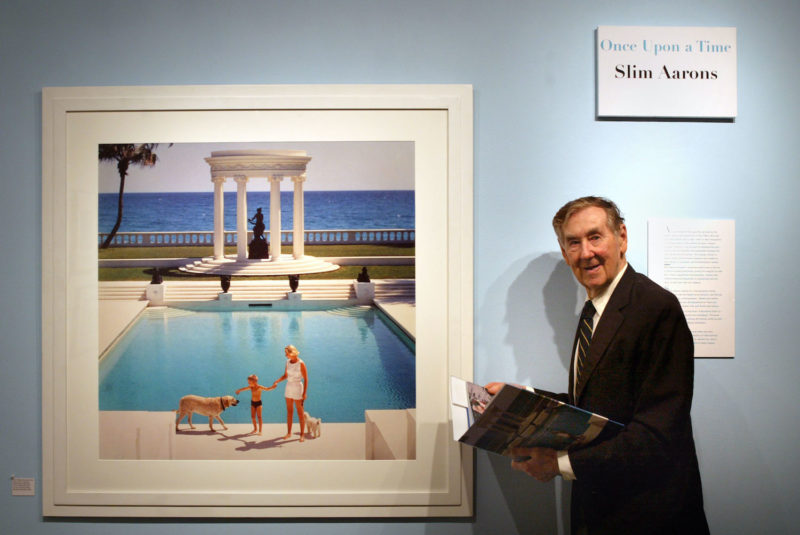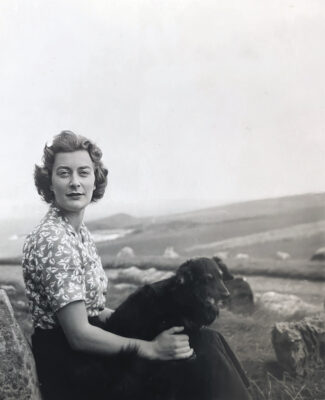
Society
Poolside revisited
The story behind the photo (taken at the Palm Beach estate rumored to be a future home for Jeff Bezos and Lauren Sanchez) that enshrined Villa Artemis (and C.Z. Guest) as the reigning symbol of post-war American Aristocracy.
As reports emerge about Jeff Bezos and Lauren Sanchez eyeing the famed Villa Artemis (whisper-listed at $350 million) and Feud: Capote vs. The Swans premiering in January 2024, followed by Palm Royale in March 2024—not to mention Palm Beach being the home to a certain former president—the exclusive Florida enclave is squarely in the global consciousness.
DP takes a look back at the photograph that put the town—and estate—squarely in the American WASP pantheon.
It’s an odd choice for an iconic picture. The light is coming directly from above and it’s harsh. The sun sharply reflects off the white marble around the pool. A blonde woman dressed in white shorts and barefoot holds the hand of her son, a boy with a buzzed haircut who is about to pat a blond Labrador. Short shadows make spaces seem smaller. Angles are off. The subjects are looking away from the camera. Even the dogs seemed to want to get the hell out of there.
Another photographer might have discarded the shot as an outtake from the shoot—others from that day certainly had more conventional compositions. Instead, the image, taken in 1955, became the symbol of the American aristocratic elite at the pinnacle of post-war success.
Archly named Nice Pool, it achieved with one click of the camera the kind of social clout it would take an Instagram influencer years to build up today. From the moment the image first appeared, the world was mesmerized. The artist and his muse—well-known in the smaller society world they traveled in—suddenly became globally famous.
The lensman was Slim Aarons, then America’s premier lifestyle photographer. The blonde woman was C. Z. Guest, wife of Phipps steel heir Winston F. Guest—and my great aunt; the boy, her son (and my cousin), Alexander Guest; the house, Villa Artemis, the Palm Beach estate built in 1916 for C. Z.’s mother-in-law, the formidable heiress Amy Phipps Guest, whose father was Andrew Carnegie’s partner at Carnegie Steel.
I spoke with Laura Hawk, Aaron’s long-time assistant and the author of Slim Aarons, Women (Abrams, 2016) about the photographer, C. Z., their surprisingly competitive relationship, and the shot that came to embody the WASP ideal.

Daisy Prince: One of the most important relationships in C.Z’s life—because he helped create the “brand” of C. Z.—was with Slim Aarons. It was symbiotic: his photos of her increased the demand for his work, and she became famous as a result. He needed her beauty, her glamor, and that amazing-looking pool. And she needed him to put her there.
Even though I’m her great-niece, I’m not a C. Z. worshiper. There are things I greatly admire about her, but I also see her very much for who she was and how she sometimes behaved. While she was kind to me, she didn’t always treat people well. If anybody was in her direct line, she could be a pill.
Laura Hawk: The women of that era perfected the ability to laser in on who was beneficial, and “cancel,” as everybody says today, those who weren’t. That’s just how it was.
DP: They were ruthless. If it had been a different time and they’d been better educated and taught that they could also do what men did, they would have been running Fortune 500 companies. They had so much energy.
LH: Women’s power in those days was all about the social ladder. That’s all they had to exert their brilliance and power.
DP: How did the relationship play out between Slim and C. Z.?
LH: I met C. Z. two or three times with Slim when they were much older, always at some sort of function. The first word that comes to mind between them is “prickly.” Slim got quite cranky in his older years. And he was sort of impatient with everybody, especially people who had any point of view and who didn’t adulate him nonstop—which I’m sure C. Z. did not do.
DP: It’s interesting to know they weren’t super-great buddies.
LH: I got the feeling they were in a bit of competition.
DP: She competed with everybody though, so that wasn’t unusual. Not people who were much younger, but she was a competitive lady.
Was Slim gossipy?
LH: No. He loved to hold court and be the raconteur. And he loved telling his stories over and over again. But he wasn’t bitchy. He had no interest in the ins and outs of people’s lives. He was a little narcissistic in that way. I think he was so driven by his art that nothing else really mattered to him.

DP: He did choose that iconic image. Of all of the people he photographed for his second book, this one really stood out. Perhaps he knew he’d captured the American Dream right there.
LH: I do think he understood very deeply that that image, along with Kings of Hollywood—[a photo of Clark Gable, Van Heflin, Gary Cooper, and James Stewart at a New Year’s party], the other image of his that comes to mind that just made him—struck a note in humanity. He loved that [Nice Pool] picture so much. He just loved what it did for him.
I’m the same way about Slim as you are with C. Z.: I don’t mind speaking my mind about him. To me, it was the whole package that made him so fascinating. Not just all of the wonderful things about him, but the difficult things too—this incredible mixture of good, bad, smart, dumb. . .
DP: If he was a plain vanilla person, I don’t think he would have gotten where he wanted to go. And the story of him being Jewish from the Lower East Side but pretending to be from New Hampshire, that’s pretty interesting too. He was totally self-made.
LH: I didn’t know he was Jewish until he died. I worked for him for years and he always held true to the New Hampshire farm-boy fantasy story. And then at his funeral, his Jewish cousins from New Jersey were like, “Well, he grew up with us.” And in walks a man who was 6′ 4″—which is what Slim was—who looked exactly like him. It was his first cousin! It was a wonderful story of a double life.
DP: That’s the irony. I can’t think of a single other photographer who so perfectly captured the WASP. Even the aristocrats were surprised, like, “That’s our life? Oh, okay, great, we’ll take it.” And the person who accomplished this was an outsider hiding who he really was.
C. Z. wasn’t hiding who she was exactly—she did have Boston Brahmin ancestry. But the reality was, her father was from a nice banking family and her mother was on the stage, which was completely taboo in those days.
What’s also interesting is that C. Z. didn’t get along with her mother-in-law. They were both very strong women. I was surprised that C. Z. was allowed to be photographed at Villa Artemis.
How did Slim become friends with all these people?
LH: Slim lived to be admired. I’m sure he instinctively understood how he and C. Z. could help one another. Whether Slim liked her or not was probably immaterial. He was ambitious. He knew that he had what it took to build an amazing career within the context of high society and aristocracies. And he understood that she was an important stepping stone.

DP: The photo is so extraordinary because it’s very simple. She’s wearing no jewelry, nothing. Just shorts.
LH: It is incredibly simple, and somehow that’s part of it. And I love that in some renditions, the pool is a beautiful aqua color, while in others it’s more of a stark blue.
DP: In your book, Slim Aarons: Women, you explain that he would spend all day setting up a shot but make it look like he just walked in and snapped it. Did he spend any time on the composition of this photo?
LH: There’s a wonderful anecdote that Slim wouldn’t stop smoking for years because he rarely saw a place before he walked in to photograph it. And smoking was a way for him to excuse himself and walk around to take stock. I can see him walking into [Villa Artemis] and asking C. Z., “Could you walk down there and around the pool a little bit?” And then Alexander maybe runs out, and it all just came together so incredibly.
DP: It looks like it was shot at midday? The light is surprisingly harsh for this kind of straightforward shot.
LH: It looks like one or two o’clock. Who would have thought a photo taken at that time would work? In other pictures taken that day, C. Z. is walking among the columns, but she’s covered. And there’s an amazing one of her in a wicker chair. Why is that one not the one? Perhaps because you can’t see the ocean behind it?
DP: Anybody who sees Nice Pool basically wants to take out their arm and go, “Ah, there’s me. I want to be doing this in this beautiful pool with the beautiful wife, the beautiful child, the dogs.” It really was the beginning of the influencer—I hate that word, but it’s here. So she was—they both were—the influencers of their day.
This interview has been edited and condensed for clarity.
Slim Aarons’ iconic photo of socialite C.Z. Guest and her son, Alexander, in front of the Grecian temple pool at Villa Artemis in Palm Beach in 1955



